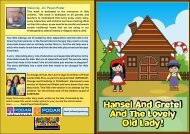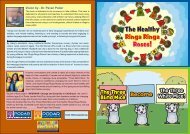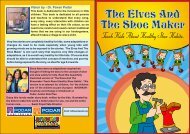piggy on the railway-the new ding dong bell - Podar Jumbo Kids Plus
piggy on the railway-the new ding dong bell - Podar Jumbo Kids Plus
piggy on the railway-the new ding dong bell - Podar Jumbo Kids Plus
- No tags were found...
You also want an ePaper? Increase the reach of your titles
YUMPU automatically turns print PDFs into web optimized ePapers that Google loves.
Visi<strong>on</strong> by - Dr. Pavan <strong>Podar</strong>This book is dedicated to <strong>the</strong> innocence in little children. This bookis dedicated to all parents and teachers to understand that everys<strong>on</strong>g, every story, every interacti<strong>on</strong> with children can have alasting effect <strong>on</strong> <strong>the</strong>ir life values, so we need to be careful andrework certain traditi<strong>on</strong>al forms that we are using in ourkindergartens, afterall it takes a village to raise a child.PiggyOnTheRailway...Revisited"S<strong>on</strong>gs and rhymes" are an essential part of early language experiences for infants andtoddlers, and include making, listening to, and reacting to sounds and also engaging inspoken language experiences such as 'made up s<strong>on</strong>gs', or listening to s<strong>on</strong>gs and rhymes.Problematic language in nursery rhymes.By today's standards, many traditi<strong>on</strong>al Mo<strong>the</strong>r Goose-type nursery rhymes can seemviolent, racist, sexist, or ageist. The Old Woman Who Lived in a Shoe is far from a lovingmo<strong>the</strong>r, and Old Mo<strong>the</strong>r Hubbard has <strong>on</strong>ly a b<strong>on</strong>e for her starving dog. In fact, traditi<strong>on</strong>alpoems and s<strong>on</strong>gs in many cultures have elements that are of questi<strong>on</strong>able appropriatenessfor young children.Even though infants and toddlers will not understand many of <strong>the</strong> words or fullycomprehend <strong>the</strong> messages, teachers and parents should be selective in <strong>the</strong>ir choice ofrhymes to share or use with children.It seems unnecessary and unwise to reject all nursery rhymes <strong>on</strong><strong>the</strong> basis of a few, especially if verses can be altered slightly tomake <strong>the</strong> words, <strong>the</strong>me, or message more acceptable. Piggy <strong>on</strong><strong>the</strong> Railway for example - <strong>the</strong> engine driver in <str<strong>on</strong>g>piggy</str<strong>on</strong>g> <strong>on</strong> <strong>the</strong> <strong>railway</strong>can say, “I will take more care”, instead of saying, “I d<strong>on</strong>'t care” andinstead of, ‘The cat fell into <strong>the</strong> well’, we can say ‘The cat hassomething to tell’.As part of <strong>the</strong>ir project- 'AVISHKAR- Change and Creativity in Childhood', <strong>the</strong> level 3children (age 5) of <strong>Podar</strong> <strong>Jumbo</strong> <strong>Kids</strong> <strong>Plus</strong>, al<strong>on</strong>g with <strong>the</strong>ir teachers worked <strong>on</strong> changingsome comm<strong>on</strong> s<strong>on</strong>gs and rhymes and make <strong>the</strong>m more healthy for childhood.Enjoy this booklet that has -Piggy On The Railway... Revisited and The New Ding D<strong>on</strong>gBell did not fall, written by <strong>the</strong> kids, illustrated by <strong>the</strong> kids to make this world a better placefor you, me and <strong>the</strong> entire human race…………. Swati Popat Vats-Director.Email: talktous@podar.orgThe NewDing D<strong>on</strong>g Bell
<strong>Podar</strong> <strong>Jumbo</strong> <strong>Kids</strong> <strong>Plus</strong>-IShift B. Level 3. Div K-D<strong>Podar</strong> <strong>Jumbo</strong> <strong>Kids</strong> <strong>Plus</strong>-IShift B. Level 3. Div K-CMelanie MathiasPedagogistDevangi LodayaSupervisorSheetal MehtaMain TeacherGopika KhandwalaAss TeacherYogita PatilDidiMelanie MathiasPedagogistDevangi LodayaSupervisorN.SunithaMain TeacherPo<strong>on</strong>am KareliaAsst TeacherSamidha MunjDidiVivaan SanghviViraj SinhaViraj ParekhShreya PrasadSana MaganShrey LakhaniShanit GhoseRohan ShirodkarRehaan RamsinghaniaNaisha ThakkarRuhaan DoshyPehel KeniaMehak Gala Khwaahish Shah Aarav PatelMoksh PuriMahema SinghKunj PatelKrrish GuptaKhwaish ChhabraJiya KherIshaan ChakHaaziq KhanDiya PurohitAnand GopalakrishnanKhayal ShahKavita BallaniFarish PradhanDeeyan ParswaniAnokkhi ShahKadesh VermaAryan KadamAnjali BordaAnaita KhatriVea JainTejas Chakrabarti
Why did we want to changePiggy <strong>on</strong> <strong>the</strong> Railway?Such an innocent rhyme but look at <strong>the</strong> mean behavior lurking in it. Anengine driver hurts a <str<strong>on</strong>g>piggy</str<strong>on</strong>g> and <strong>the</strong>n says, “I d<strong>on</strong>'t care!” This s<strong>on</strong>g is sung atan age when we are trying to teach kids 'manners'. So, aren't we justc<strong>on</strong>fusing <strong>the</strong>m with <strong>the</strong> c<strong>on</strong>tradicti<strong>on</strong>s?At <strong>Podar</strong> <strong>Jumbo</strong> <strong>Kids</strong> <strong>Plus</strong> c<strong>on</strong>flict resoluti<strong>on</strong> skills are given due importanceto teach kids and teachers that <strong>the</strong>re is always a soluti<strong>on</strong> to every problem.And ‘Discussi<strong>on</strong> starters’ help in identifying <strong>the</strong> problem and <strong>the</strong>n probing for<strong>the</strong> soluti<strong>on</strong>s. Soluti<strong>on</strong>s that are acceptable to <strong>the</strong> whole group.While discussing Piggy <strong>on</strong> <strong>the</strong> Railway, it was surprising to realize that mostof <strong>the</strong> kids blamed <strong>the</strong> <str<strong>on</strong>g>piggy</str<strong>on</strong>g> for being in <strong>the</strong> way. Yes, <strong>the</strong> <str<strong>on</strong>g>piggy</str<strong>on</strong>g> was wr<strong>on</strong>gto be picking up st<strong>on</strong>es <strong>on</strong> <strong>the</strong> <strong>railway</strong> tracks; but, does that mean <strong>the</strong> enginedriver has to be mean and not say sorry?Old versi<strong>on</strong>Piggy OnThe Railway‘Discussi<strong>on</strong> starters’ help us identify <strong>the</strong> cobwebs in our value system, in ourthinking styles and <strong>the</strong>n help us see more clearly what is <strong>the</strong> right way. Andthat's exactly what emerged from this ‘Discussi<strong>on</strong> starter’; an engine driverwho was sensitive and said, “sorry” and yes <strong>the</strong> <str<strong>on</strong>g>piggy</str<strong>on</strong>g> too should not cross<strong>on</strong> <strong>the</strong> <strong>railway</strong> track!Enjoy <strong>the</strong>se little <strong>new</strong> rhymes.Notice <strong>the</strong> Documentati<strong>on</strong> in <strong>the</strong> DrawingsYou will notice that all <strong>the</strong> children’s drawingshave comments written by <strong>the</strong> Teacher. This iscalled Documentati<strong>on</strong>-a Practice adopted by usfrom Reggio schools where a teacher ask <strong>the</strong>child about <strong>the</strong> drawings and <strong>the</strong>n writes downall points that were menti<strong>on</strong>ed by <strong>the</strong> child.
Piggy <strong>on</strong> <strong>the</strong> RailwayPicking up st<strong>on</strong>es;
Down came an engine,And broke Piggy's b<strong>on</strong>es.‘Ah!' said Piggy,“That's not fair”“Oh!” said <strong>the</strong> engine driver,“I d<strong>on</strong>'t care!”
Why did we want to changePiggy <strong>on</strong> <strong>the</strong> Railway?Such an innocent rhyme but look at <strong>the</strong> mean behavior lurking in it. Anengine driver hurts a <str<strong>on</strong>g>piggy</str<strong>on</strong>g> and <strong>the</strong>n says, “I d<strong>on</strong>'t care!” This s<strong>on</strong>g is sung atan age when we are trying to teach kids 'manners'. So, aren't we justc<strong>on</strong>fusing <strong>the</strong>m with <strong>the</strong> c<strong>on</strong>tradicti<strong>on</strong>s?At <strong>Podar</strong> <strong>Jumbo</strong> <strong>Kids</strong> <strong>Plus</strong> c<strong>on</strong>flict resoluti<strong>on</strong> skills are given due importanceto teach kids and teachers that <strong>the</strong>re is always a soluti<strong>on</strong> to every problem.And ‘Discussi<strong>on</strong> starters’ help in identifying <strong>the</strong> problem and <strong>the</strong>n probing for<strong>the</strong> soluti<strong>on</strong>s. Soluti<strong>on</strong>s that are acceptable to <strong>the</strong> whole group.While discussing Piggy <strong>on</strong> <strong>the</strong> Railway, it was surprising to realize that mostof <strong>the</strong> kids blamed <strong>the</strong> <str<strong>on</strong>g>piggy</str<strong>on</strong>g> for being in <strong>the</strong> way. Yes, <strong>the</strong> <str<strong>on</strong>g>piggy</str<strong>on</strong>g> was wr<strong>on</strong>gto be picking up st<strong>on</strong>es <strong>on</strong> <strong>the</strong> <strong>railway</strong> tracks; but, does that mean <strong>the</strong> enginedriver has to be mean and not say sorry?‘Discussi<strong>on</strong> starters’ help us identify <strong>the</strong> cobwebs in our value system, in ourthinking styles and <strong>the</strong>n help us see more clearly what is <strong>the</strong> right way. Andthat's exactly what emerged from this ‘Discussi<strong>on</strong> starter’; an engine driverwho was sensitive and said, “sorry” and yes <strong>the</strong> <str<strong>on</strong>g>piggy</str<strong>on</strong>g> too should not cross<strong>on</strong> <strong>the</strong> <strong>railway</strong> track!Level 3Rework‘Change and Creativity’to CreatePiggy OnThe RailwayEnjoy <strong>the</strong>se little <strong>new</strong> rhymes.Notice <strong>the</strong> Documentati<strong>on</strong> in <strong>the</strong> DrawingsYou will notice that all <strong>the</strong> children’s drawingshave comments written by <strong>the</strong> Teacher. This iscalled Documentati<strong>on</strong>-a Practice adopted by usfrom Reggio schools where a teacher ask <strong>the</strong>child about <strong>the</strong> drawings and <strong>the</strong>n writes downall points that were menti<strong>on</strong>ed by <strong>the</strong> child.
Piggy <strong>on</strong> <strong>the</strong> Railway,Picking up st<strong>on</strong>es;
Down came an engine,And broke Piggy's b<strong>on</strong>es.'Ah!' said Piggy,“That's not fair”“Sorry!” said <strong>the</strong> engine driver,“I will take more care.”
Why did we want to changeDing D<strong>on</strong>g Bell?A nursery rhyme, that talks about a cat being pushed into a well;and who was to be blamed for it? A fat little boy! The rhyme not<strong>on</strong>ly teaches kids to be cruel to animals but also somewhereplants <strong>the</strong> seeds of fat and thin in <strong>the</strong> minds of children and thus,starting kids off <strong>on</strong> a foundati<strong>on</strong> of bias where looks arec<strong>on</strong>cerned.Values and morals cannot be taught to young children, <strong>the</strong>y needto imitate <strong>the</strong>m from o<strong>the</strong>rs. Unknowingly we are teaching <strong>the</strong>mabout and exposing <strong>the</strong>m to many unwanted acts of violence, andsocial bias, through <strong>the</strong> stories and s<strong>on</strong>gs that we sing to <strong>the</strong>m inschools or as bed time stories.Old versi<strong>on</strong>Ding D<strong>on</strong>g Bell‘Discussi<strong>on</strong> starters’ help kids understand and questi<strong>on</strong> <strong>the</strong> wr<strong>on</strong>gand replace with <strong>the</strong> right. And that's exactly what <strong>the</strong> kids ofLevel 3 did with <strong>the</strong>se two rhymes, we discussed its relevance togood and bad and <strong>the</strong>n identified what needed to be changedand had fun playing with words to find <strong>the</strong> replacements.So, it was a value educati<strong>on</strong> sessi<strong>on</strong> and a language sessi<strong>on</strong> allrolled into <strong>on</strong>e. Come enjoy <strong>the</strong> <strong>new</strong> versi<strong>on</strong>s of both <strong>the</strong>sepreschool favourites and help kids grow up with healthy valuesand language skills.Notice <strong>the</strong> Documentati<strong>on</strong> in <strong>the</strong> DrawingsYou will notice that all <strong>the</strong> children’s drawingshave comments written by <strong>the</strong> Teacher. This iscalled Documentati<strong>on</strong>-a Practice adopted by usfrom Reggio schools where a teacher ask <strong>the</strong>child about <strong>the</strong> drawings and <strong>the</strong>n writes downall points that were menti<strong>on</strong>ed by <strong>the</strong> child.
Ding d<strong>on</strong>g <strong>bell</strong>,The cat is in <strong>the</strong> well.Who put her in? Little Johnny Green.
Who pulled her out?Little Tommy Stout.What a naughty boy was that,To try to drown <strong>the</strong> poor cat.
Why did we want to changeDing D<strong>on</strong>g Bell?A nursery rhyme, that talks about a cat being pushed into a well;and who was to be blamed for it? A fat little boy! The rhyme not<strong>on</strong>ly teaches kids to be cruel to animals but also somewhereplants <strong>the</strong> seeds of fat and thin in <strong>the</strong> minds of children and thus,starting kids off <strong>on</strong> a foundati<strong>on</strong> of bias where looks arec<strong>on</strong>cerned.Values and morals cannot be taught to young children, <strong>the</strong>y needto imitate <strong>the</strong>m from o<strong>the</strong>rs. Unknowingly we are teaching <strong>the</strong>mabout and exposing <strong>the</strong>m to many unwanted acts of violence, andsocial bias, through <strong>the</strong> stories and s<strong>on</strong>gs that we sing to <strong>the</strong>m inschools or as bed time stories.‘Discussi<strong>on</strong> starters’ help kids understand and questi<strong>on</strong> <strong>the</strong> wr<strong>on</strong>gand replace with <strong>the</strong> right. And that's exactly what <strong>the</strong> kids ofLevel 3 did with <strong>the</strong>se two rhymes, we discussed its relevance togood and bad and <strong>the</strong>n identified what needed to be changedand had fun playing with words to find <strong>the</strong> replacements.So, it was a value educati<strong>on</strong> sessi<strong>on</strong> and a language sessi<strong>on</strong> allrolled into <strong>on</strong>e. Come enjoy <strong>the</strong> <strong>new</strong> versi<strong>on</strong>s of both <strong>the</strong>sepreschool favourites and help kids grow up with healthy valuesand language skills.Level 3Rework‘Change and Creativity’to CreateThe NewDing D<strong>on</strong>g BellNotice <strong>the</strong> Documentati<strong>on</strong> in <strong>the</strong> DrawingsYou will notice that all <strong>the</strong> children’s drawingshave comments written by <strong>the</strong> Teacher. This iscalled Documentati<strong>on</strong>-a Practice adopted by usfrom Reggio schools where a teacher ask <strong>the</strong>child about <strong>the</strong> drawings and <strong>the</strong>n writes downall points that were menti<strong>on</strong>ed by <strong>the</strong> child.
Ding d<strong>on</strong>g <strong>bell</strong>,The cat has something to tell.Never pull my tail,
And throw no st<strong>on</strong>es at me.Treat me with love and,I will help you keep <strong>the</strong> mice away.








